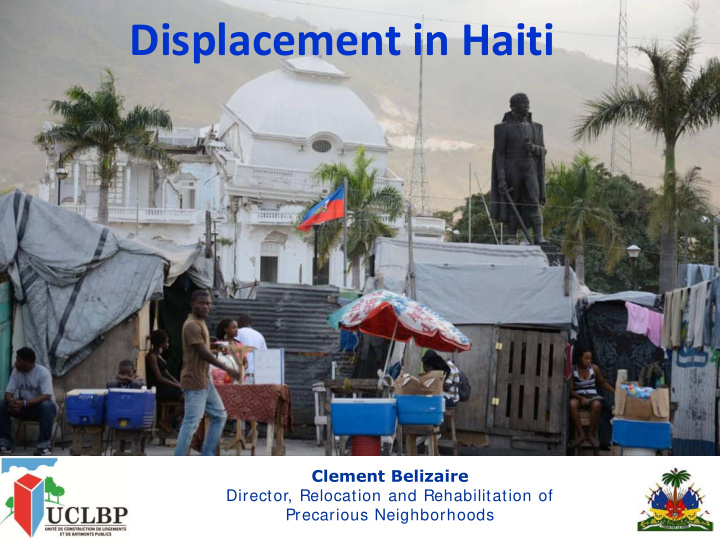



Displacement in Haiti Clement Belizaire Director, Relocation and Rehabilitation of Precarious Neighborhoods
Displacement in Haiti Challenges are particularly acute when there is a combination of: Poverty Political instability History of weak Government; Environmental degradation and Natural disasters
The Reality faced by actual Government Jan 2010 earthquake has caused severe damage: • 250,000 homes destroyed • 10 Billion in dammage • 1.5 MM people displaced • 630,000 still living in Camps • 80% of IDP’S come from vulnerable areas • No sustainable solutions • Uncertain future
The Government’s standpoint IDP camps represent a high sanitary risk The Reconstruction has to be launched The camps are blocking reconstruction efforts The camps are absorbing precious financial ressources The government commits to bring back the IDP’s home
Scale of the Displacement Ongoing Displacement Crisis: • 2 years on • Almost half a million people • 660 camps • 120,000 families [Source: IOM Data Management Team]
The context • During the first year of the displacement crisis there was a crisis of coordination for reconstruction – Multiple Government agencies, – Multiple UN agencies, – International Organizations – hundreds of NGOs • Working across multiple domains: – Camp management – Housing construction – Urban Planning – Water – Sanitation – Basic services…etc • After his election in May 2011 President Martelly set up one Housing and Reconstruction Agency to coordinate reconstruction and the policy on assisting IDPs called UCLBP
UCLBP “Unite de Construction de Logements et des Batiments Publics” The Housing UCLBP has three main divisions: UCLBP DIVISION DIVISION DIVISION BATIMENTS REHABILITATION LOGEMENTS PUBLICS ET RELOGEMENT 16 Neighborhood 6 camps project
16 /6 approach case study Before and After Place Saint Pierre
16 /6 approach case study Place Saint Pierre 575 families lived in Place Saint Pierre Even apart from the families living there there is huge cultural value to this site : where young and old poor and rich come together to breathe and relax All the services around this camp: • Town hall • Church , Police Precint • Schools , Hotel Kinam
Place Saint Pierre Today
Place Saint Pierre Today
Why 16/6 ??? One Example Problem: Year 1 housing solutions fail to close camps Year 1 Yellow House Repairs Transitional Shelters Permanent Housing
16/6 Approach to Displacement: Choice – including Rental Support Cash Grants Year 1 Year 2 – 16/6 Approach
Camp Closure based on Informed Voluntary Choice The reasons for displacement are varied Therefore every family was offered the choice 3 options: •Repair Damaged “Yellow” Houses •Demolish and Rebuild “Red” Houses • Rental Support cash grant – $500 Rental support – $25 Transport – $125 6-12 weeks later
More than Camp Closure: Neighborhood Approach • Registration • Communication • Identify with each family their solution IOM • Cash transfers • Camp closure UNOPS • Yellow House repair • Red House demolition & new house construction • Basic infrastructure investments • Income generation • Community-based urban planning UNDP • Risk Mapping ILO • Professional Training
Government of Haiti Return and Reconstruction Policy Camp Closure Reconstruction Concern IFRC World USAID Gymnasium 16 / 6 Zoranje Vision 15,000 Housing Place Champs CRS CARMEN Support Jeremie de Mars Project NFI J/P HRO Returns
What is the “16/6 Methodology” ? “16/6 Methodology” Registration Rental Support Communications An approach to camp closure based on voluntary choice of housing Camp Choice of 3 housing solutions solutions including but not limited to Yellow, Red, Rental $500 Rental Support of $500 Monitoring & Evaluation Visit ($125) Yellow House Red House - Permanent Community Infrastructure Community Professional Training Income Generation Community Planning Risk Mapping
What is the “16/6 Methodology” ? “16/6 Methodology” Registration Rental Support Communications An approach to camp closure based on voluntary choice of housing Camp Choice of 3 housing solutions solutions including but not limited to Yellow, Red, Rental $500 Rental Support of $500 Monitoring & Evaluation Visit and ($125) Yellow House Rebuilding Neighborhoods Red House - Permanent Community Infrastructure A large scale investment in housing, infrastructure and economic Community Professional Training development in neighborhoods Income Generation Community Planning Risk Mapping
Financial Focus on the Neighborhoods Because there is a 1:10 cost ratio “16/6 Methodology” using the 16/6 budget as a guide Registration Communications $ 77 million $ 7.7 million Camp Choice of 3 housing solutions Yellow, Red, Rental $500 Monitoring & Evaluation Visit ($125) Yellow House Red House - Permanent Community Infrastructure Community Professional Training Income Generation Community Planning Risk Mapping
Final Outcome of 16/6 methodology Permanent Job and Risk reduction Choices of Return Of IDP’s Basic Services economic in the Housing accessible opportunity in their neighborhoods solutions creation neighborhoods
One Approach Among Many • The 16/6 model is only one approach • There are still more than 600 camps in Haiti • 16/6 – style investment in housing and infrastructure will not be possible for every camp and every neighborhood • The Government of Haiti is also working on other approaches • Some of the possible approaches are explored in IOM’s paper Many Roads Lead Home
Process and Strategy Documentation Available Housing Needs Analysis Rental Support Cash Grants Lessons Learned 16/6 Camp Closure Process http://www.eshelter-cccmhaiti.info/
Recommend
More recommend